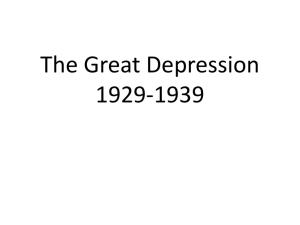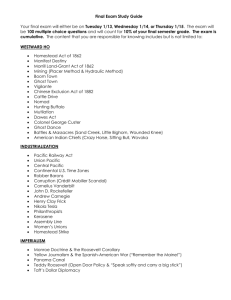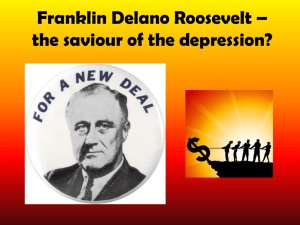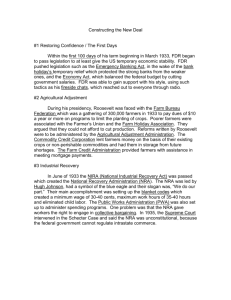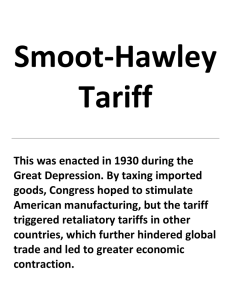File - Mr. Patrick's IB Hub
advertisement
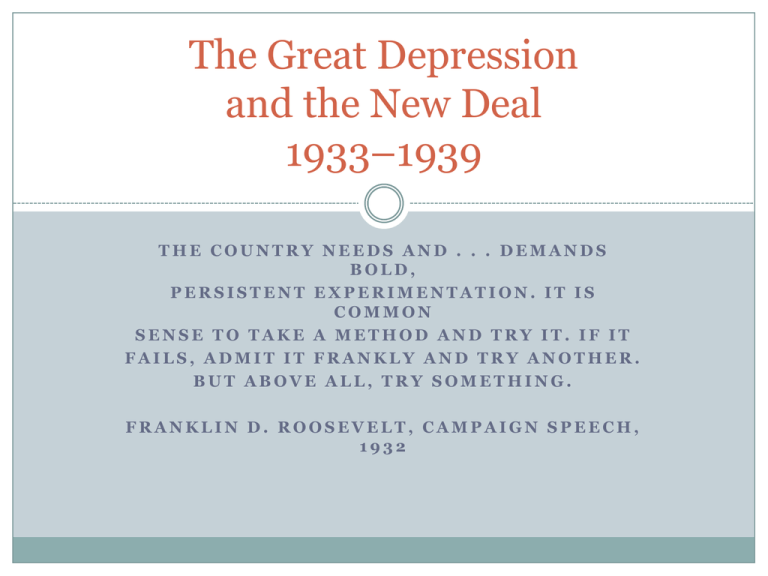
The Great Depression and the New Deal 1933–1939 THE COUNTRY NEEDS AND . . . DEMANDS BOLD, PERSISTENT EXPERIMENTATION. IT IS COMMON SENSE TO TAKE A METHOD AND TRY IT. IF IT FAILS, ADMIT IT FRANKLY AND TRY ANOTHER. BUT ABOVE ALL, TRY SOMETHING. FRANKLIN D. ROOSEVELT, CAMPAIGN SPEECH, 1932 Economic Weaknesses in the USA International economic problems – protectionism, taxes, instability, reparations cont. Reparations Because the US was demanding repayment, the French and British demanded that the Germans pay $32 billion. The French hoping to increase lagging reparation payments, sent troops to the Ruhr Valley in 1923. Germany had little choice but to print lots of money causing hyperinflation. Dawes Plan, 1924 Temporarily helped Germany pay loans until the stock market crashed in Oct. 1929. Created a cycle: US banks loaned money to Germany Germany paid reparations to France and Britain France and Britain paid war debts to the US Interdependence meant that a setback in the US economy would be felt abroad. What was President Hoover’s response to the Great Depression? Hoover initially downplayed the Wall Street Crash and subsequent Great Depression as part of “a natural economic cycle, the terrible effects of which would simply have to be borne until better times arrived”. Charges against Hoover “Rugged individualism” Believed that too much government interference in economic and social matters would destroy the individual and ultimately the nation. Promoted the voluntary action of: state governments maintaining spending farmers in reducing production employers sustaining wages bankers extending credit Believed unemployment relief should come from private charity and from the local or state-level government. (ie/ not federal) "It is not the function of the government to relieve individuals of their responsibilities to their neighbors, or to relieve private institutions of their responsibilities to the public." - Hoover 1932 Election: Hoover (R) vs Roosevelt (D) FDR was a governor of New York and was seen as a moderate reformer who tried to help those in need. Little in his career to suggest his future greatness; many thought him a “lightweight” Republican vs Democrat Plans were much the same except the Democrats pledged to end Prohibition (devolution to state jurisdiction) FDR’s campaign was upbeat with the tune “Happy Days Are Here Again” as a theme; however, he did not make any revolutionary promises In contrast, Hoover’s campaign was more gloomy FDR had an inconsistent message: he spoke of both cutting the federal budget and spending more on jobs. 1932 acceptance speech FDR promised a “new deal for the American people” and “bold, persistent experimentation.” Did not clearly define what he was going to do FDR won 472 electoral college votes to Hoover’s 59 electoral college votes (popular vote: 22.8 million to 15.8 million) March, 1933, FDR takes power and proclaims that “the only thing we need to fear is fear itself” FDR and the Three R’s: Relief, Recovery, Reform Hundred Days (March 9–June 16, 1933) Members hastily cranked out an unprecedented basketful of remedial legislation Some of it derived from earlier progressivism, but these new measures mostly sought to deal with a desperate emergency. “Let me assert my firm belief that the only thing we have to fear is fear itself.” Principal New Deal Acts During Hundred Days Congress, 1933 FDR closes banks, March 6, 1933 Emergency Banking Relief Act, March 9, 1933 Beer and Wine Revenue Act, March 22, 1933 Unemployment Relief Act, March 31, 1933, creates Civilian Conservation Corps (CCC) Federal Emergency Relief Act, May 12, 1933, creates Federal Emergency Relief Administration (FERA) Agricultural Adjustment Act (AAA), May 12, 1933 Tennessee Valley Authority Act (TVA), May 18, 1933 Federal Securities Act, May 27, 1933 Home Owners’ Refinancing Act, June 13, 1933, creates Home Owners’ Loan Corporation (HOLC) National Industrial Recovery (NRA, PWA) (NRA) Act, June 16, 1933, creates National Recovery Administration (NRA), Public Works Administration (PWA) Glass-Steagall Banking Reform Act, June 16, 1933 Hundred Days Congress passed many essentials of the New Deal “three R’s” The New Dealers began to embraced such progressive ideas as: unemployment insurance old-age insurance minimum-wage regulations conservation and development of natural resources and restrictions on child labor. A few such reforms had already made limited gains in some of the states. Many of these forward-looking measures had been adopted a generation or so earlier by the more advanced countries of western Europe. Roosevelt Manages the Money Emergency Banking Relief Act of 1933 – gave the president the power to regulate banking transactions and foreign exchange and to reopen solvent banks. FDR followed up with the first of 30 ‘fireside chats’ Some 35 million people tuned in as he gave assurances that it was now safer to keep money in a reopened bank than “under the mattress.” Confidence returned with a gush, and the banks began to unlock their doors. Roosevelt Manages the Money Glass-Steagall Banking Reform Act Measure provided for the Federal Deposit Insurance Corporation Insured individual deposits up to $5,000 (later raised). Creating Jobs for the Jobless One out of every four workers was jobless when FDR took his inaugural oath Highest level of unemployment in the nation’s history Civilian Conservation Corps (CCC) Law provided employment in fresh-air government camps for about 3 million uniformed young men Many of whom might otherwise have been driven by desperation into criminal habits. Their work included: Reforestation Firefighting (forty-seven lost their lives) Flood control and swamp drainage The recruits were required to help their parents by sending home most of their pay. Both human resources and natural resources were thus conserved CCC Workers in Alaska, 1939 Creating Jobs for the Jobless Federal Emergency Relief Act Chief aim was immediate relief rather than long-range recovery. Agency in all granted about $3 billion to the states Agricultural Adjustment Act (AAA) Made available many millions of dollars to help farmers meet their mortgages. Home Owners’ Loan Corporation (HOC) Designed to refinance mortgages on nonfarm homes Ultimately assisted about a million households The agency not only bailed out mortgage-holding banks, it also bolted the political loyalties of relieved middle-class homeowners securely to the Democratic party. Civil Works Administration (CWA) Designed to provide purely temporary jobs during the cruel winter emergency Tens of thousands of jobless were employed at leaf raking and other make-work tasks, which were dubbed “boondoggling.” As this kind of labor put a premium on shovel-leaning slow motion, the scheme was widely criticized. “The only thing we have to fear,” scoffers remarked, “is work itself.” New Visibility for Women Just over a decade after the ratification of the Nineteenth Amendment, American women began to carve a larger space for themselves in the nation’s political and intellectual life. Secretary of Labor Frances Perkins (1880– 1965) Mary McLeod Bethune (1875–1955), director of the Office of Minority Affairs in the National Youth Administration, served as the highest-ranking African American in the Roosevelt administration This was a time were women also played an important role in social sciences (Ruth Benedict and Margaret Mead) as well as literature (Pearl S. Buck 1938 Nobel Prize winner). Paying Farmers Not to Farm Ever since the war-boom days of 1918, farmers had suffered from low prices and overproduction, especially in grain. During the depression, conditions became desperate as innumerable mortgages were foreclosed, as corn was burned for fuel, and as embattled farmers tried to prevent shipment of crops to glutted markets. In Iowa several volatile counties were placed under martial law. Agricultural Adjustment Administration (AAA) Through “artificial scarcity” this agency was to establish “parity prices” for basic commodities. The AAA would eliminate price depressing surpluses by paying growers to reduce their crop acreage. The Supreme Court finally killed the AAA in 1936 by declaring its regulatory taxation provisions unconstitutional Quickly recovering from this blow, the New Deal Congress hastened to pass the Soil Conservation and Domestic Allotment Act of 1936. Dust Bowls and Black Blizzards The Extent of Erosion in the 1930s: Note the extensive wind erosion in the western Oklahoma “panhandle” region, which was dubbed the “Dust Bowl” in the 1930s. Mechanized farmers had “busted” the sod of the southern plains so thoroughly that they literally broke the back of the land. Tons of dust blew out of the Dust Bowl in the 1930s and blotted the sun from the skies as far away as New York. Native Americans and the Great Depression Commissioner of Indian Affairs John Collier ardently sought to reverse the forced assimilation policies in place since the Dawes Act of 1887 Collier promoted the Indian Reorganization Act of 1934 (the “Indian New Deal”). The new law encouraged tribes to establish local self-government and to preserve their native crafts and traditions. The act also helped to stop the loss of Indian lands and revived tribes’ interest in their identity and culture. Yet not all Indians applauded it. Some denounced the legislation as a “back-to-the blanket” measure that sought to make museum pieces out of Native Americans. Seventy-seven tribes refused to organize under its provisions Nearly two hundred others did establish tribal governments. Later Major New Deal Measures, 1933– 1939 FDR establishes Civil Works Administration (CWA), November 9, 1933 Gold Reserve Act, January 30, 1934, authorizes FDR’s devaluation, January 31, 1934 Securities and Exchange Commission (SEC) authorized by Congress, June 6, 1934 Reciprocal Trade Agreements Act, June 12, 1934 (see pp. 802–803) Indian Reorganization Act, June 18, 1934 National Housing Act, June 28, 1934, authorizes Federal Housing Administration (FHA) Frazier-Lemke Farm Bankruptcy Act, June 28, 1934 FDR creates Resettlement Administration, April 30, 1935 FDR creates Works Progress Administration (WPA), May 6, 1935, under act of April 8, 1935 Wagner Act (National Labor Relations Act), July 5, 1935 Social Security Act, August 14, 1935 Public Utility Holding Company Act, August 26, 1935 Soil Conservation and Domestic Allotment Act, February 29, 1936 United States Housing Authority (USHA) established by Congress, September 1, 1937 Second Agricultural Adjustment Act, February 16, 1938 Fair Labor Standards Act (Wages and Hours Bill), June 25, 1938 Reorganization Act, April 3, 1939 Hatch Act, August 2, 1939 Assignment for next class: For paper 3 it will greatly increase your chances of scoring high if you have a deep understanding of three of FDR’s New Deal policies. To do: Select 3 New Deal Policies Goal Proponents? Success/Failure in ending the GD Why?
